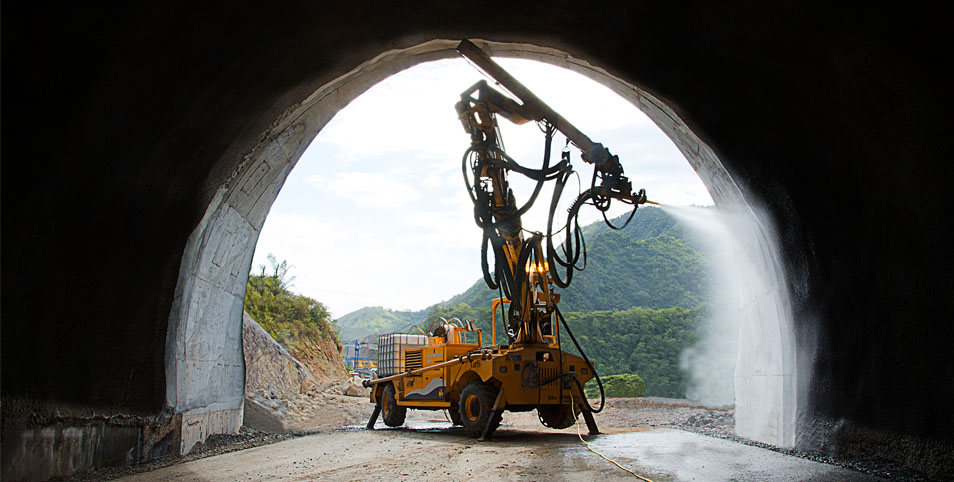The construction of tunnel linings and the application of shotcrete in mining environments are critical aspects of underground engineering. These technologies ensure the safety, stability, and longevity of underground structures in both civil engineering and mining contexts. This article explores the methods and materials used in tunnel lining construction, with a particular focus on shotcrete solutions in mining applications.
Tunnel Linings: An Overview
Tunnel linings construction serve several crucial functions in underground construction:
- Structural support: Preventing collapse and maintaining tunnel shape
- Waterproofing: Keeping groundwater out of the tunnel
- Smoothing: Creating a uniform surface for efficient air flow and aesthetics
- Protection: Shielding the surrounding rock or soil from weathering and erosion
Types of Tunnel Linings
- Cast-in-place concrete lining: Concrete poured into formwork on-site
- Precast concrete segments: Factory-made segments assembled in the tunnel
- Shotcrete lining: Sprayed concrete applied directly to the tunnel surface
- Steel lining: Used in high-pressure or watertight situations
- Composite linings: Combination of different materials for optimal performance
Shotcrete in Tunnel Lining Construction
Shotcrete has become increasingly popular in tunnel lining construction due to its versatility and efficiency.
Advantages of Shotcrete Linings
- Rapid application: Allows for quick support of newly exposed surfaces
- Flexibility: Can be applied in varying thicknesses and to irregular shapes
- Reduced excavation: Thinner lining profile compared to cast-in-place concrete
- Cost-effective: Often more economical than traditional methods
- Immediate strength gain: Provides instant support to the tunnel
Shotcrete Application Methods
- Dry-mix process: Dry materials are conveyed through the hose and mixed with water at the nozzle
- Wet-mix process: Pre-mixed concrete is pumped through the hose and sprayed
Reinforcement in Shotcrete Linings
- Fiber reinforcement: Steel or synthetic fibers mixed into the shotcrete
- Mesh reinforcement: Wire mesh fixed to the tunnel surface before spraying
- Lattice girders: Steel frames used in conjunction with shotcrete
Mining Shotcrete Solutions
In the mining shotcrete solutions industry, shotcrete plays a vital role in ground support and safety.
Applications in Mining
- Drift and tunnel support: Stabilizing newly excavated areas
- Rock face consolidation: Preventing rockfalls and spalling
- Shaft lining: Providing support in vertical or inclined shafts
- Temporary support: Offering immediate stability during excavation
- Rehabilitation: Repairing and strengthening existing mine workings
Challenges in Mining Shotcrete Application
- High-stress environments: Deep mines with significant rock pressure
- Dynamic loading: Areas subject to seismic activity or blast vibrations
- Corrosive environments: Presence of acidic water or other corrosive agents
- Remote locations: Logistical challenges in material transport and equipment maintenance
- Ventilation concerns: Managing dust and ensuring air quality during application
Innovative Shotcrete Solutions for Mining
- High-energy absorption shotcrete: Designed to deform under load without losing integrity
- Rapid-setting mixes: For immediate support in unstable ground conditions
- Alkali-free accelerators: Reducing health risks and improving long-term durability
- Automated application systems: Enhancing safety and consistency in dangerous areas
- Lightweight shotcrete: For areas with weight restrictions or poor ground conditions
Design Considerations for Tunnel Linings and Mining Shotcrete
Geological Factors
- Rock mass quality: Influencing the required thickness and strength of the lining
- Groundwater conditions: Determining waterproofing requirements
- In-situ stress state: Affecting the loading on the lining
- Potential for swelling or squeezing ground: Requiring flexible or yielding support systems
Structural Requirements
- Load-bearing capacity: Designing for both static and dynamic loads
- Durability: Ensuring long-term performance in harsh underground environments
- Flexibility: Accommodating ground movements and deformations
- Fire resistance: Particularly important in transportation tunnels
Environmental Considerations
- Groundwater protection: Preventing contamination of aquifers
- Dust control: Managing air quality during construction and operation
- Noise reduction: Minimizing disturbance to surrounding areas
- Carbon footprint: Exploring eco-friendly mix designs and application methods
Quality Control and Testing
Ensuring the quality of tunnel linings and mining shotcrete is crucial for safety and longevity.
Testing Methods
- Compressive strength testing: Core samples or test panels
- Bond strength testing: Adhesion to substrate
- Thickness measurements: Ensuring adequate coverage
- Permeability testing: For waterproofing performance
- Non-destructive testing: Ground-penetrating radar or ultrasonic methods
Monitoring and Maintenance
- Convergence monitoring: Measuring tunnel deformation over time
- Crack mapping: Identifying and tracking the development of cracks
- Regular inspections: Visual assessments and condition surveys
- Rehabilitation strategies: Timely repairs and upgrades as needed
Case Studies
1. Deep Gold Mine Support, South Africa
A deep-level gold mine implemented a high-energy absorption shotcrete system to combat rock bursts and squeezing ground conditions. The solution included:
- Fiber-reinforced shotcrete with high flexural strength
- Rapid-setting mix for immediate support
- Automated application system for enhanced safety
Results: Significant reduction in rockfall incidents and improved overall mine safety.
2. Alpine Base Tunnel, Europe
A long railway tunnel through the Alps used a combination of precast segments and in-situ shotcrete for lining:
- Precast segments in stable rock conditions
- Wet-mix shotcrete in areas of varying geology
- Composite waterproofing system with shotcrete final lining
Results: Efficient construction process and excellent waterproofing performance.
Future Trends in Tunnel Linings and Mining Shotcrete
- Smart linings: Integrated sensors for real-time monitoring
- Self-healing concrete: Materials that can repair minor cracks autonomously
- 3D printing technology: Potential for on-site production of custom lining elements
- Geopolymer shotcrete: Eco-friendly alternatives to traditional cement-based mixes
- Virtual reality training: Enhancing skills of shotcrete operators in a safe environment
Conclusion
Tunnel lining construction and mining shotcrete solutions continue to evolve, driven by the demands of increasingly challenging projects and the need for safer, more efficient underground operations. The integration of advanced materials, innovative application techniques, and sophisticated monitoring systems is pushing the boundaries of what’s possible in underground construction and mining support.
As the industry moves forward, the focus on sustainability, safety, and long-term performance will shape the development of new solutions. For professionals in tunneling and mining, staying abreast of these advancements is crucial for delivering successful projects in the complex world of underground engineering.








